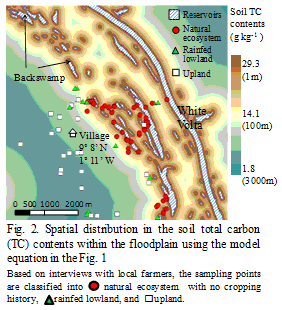Topographic distribution of the soil total carbon content and sulfur deficiency for rice cultivation in a floodplain ecosystem of the Northern region of Ghana
Description
River floodplains, consisting of wide and flat alluvial plains bordering rivers, are expected to support a large expansion in the rice cultivation area and production, the major share of which is currently unexploited in West Africa. An understanding of the spatial variation in soil fertility is fundamental for developing appropriate fertilizer management practices and extending rice cultivation in this floodplain ecosystem. This study focuses on a floodplain along the White Volta River in the Northern region of Ghana, the major rice-producing region of the country. Here, we proposed a topographic distribution model to estimate the total carbon contents of soils, and then identified specific nutrient deficiencies in growing rice by combining satellite imagery analysis, soil chemical analysis, and phytometric pot experiments.
The total carbon (TC) contents of soils (0-15 cm in depth) largely differed from 2.0 to 40.2 g kg-1, among 89 samples in the target floodplain. In the analysis using the four different topographic parameters, i.e., ‘Elevation’, ‘Distance to the White Volta river’, ‘Distance to reservoirs’, and ‘Slope angle’, the single logarithmic model of the ‘Distance to reservoirs’ was selected for estimating the soil TC contents with the greatest determination coefficient at 0.54 (Fig.1). The estimation model depicted the distribution map of soil TC contents as shown in Fig. 2, where we can find non-cultivated areas with high soil TC contents relatively close to the village compound. The soil TC contents showed close correlation with the N uptakes of rice grown under non-fertilized pot experiments (Fig.3). This result indicated that soil TC content can be used as an appropriate parameter of the soil N-supplying capacity for rice in the target ecosystem. Limited sulfur concentrations in plant tissues and a significant response to S application indicated that inherent sulfur deficiency restricted rice growth (Table 1). Therefore, fertilization of N, P, and K without S should increase only the concentration levels of these elements in rice plants but not biomass production. The effect of sulfur application on rice growth was greater with increased proximity to reservoirs.
The distribution of soil TC contents corresponded to the length of waterlogging period, which also logarithmically increased with proximity to reservoirs, as estimated by satellite imagery images. This corresponding pattern indicated that extension of rice cultivation areas near reservoirs can be regarded productive in terms of both water availability and soil fertility. Internal (soil-derived) and external nitrogen can be efficiently utilized for rice production by supplementing S-containing forms of fertilizer (e.g., ammonium sulfate). The potential risks of complete submergence should be further studied for extending rice production in this floodplain ecosystem.
Figure, table
- Affiliation
-
Japan International Research Center for Agricultural Sciences Crop, Livestock and Environment Division
- Classification
-
Administration B
- Program name
- Term of research
-
FY 2012 (FY 2011- FY2015)
- Responsible researcher
-
Tsujimoto Yasuhiro ( Crop, Livestock and Environment Division )
ORCID ID0000-0001-7738-9913KAKEN Researcher No.: 20588511Yamamoto Yukiyo ( Social Sciences Division )
Hayashi Keiichi ( Crop, Livestock and Environment Division )
Hatta Tamao ( Biological Resources and Post-harvest Division )
Sakagami Junichi ( Kagoshima University )
KAKEN Researcher No.: 70399369Fujihara Youichi ( Ishikawa Prefectural University )
KAKEN Researcher No.: 10414038Fosu Mathias ( Savanna Agricultural Research Institute, CSIR, Ghana )
Inusah Yahaya ( Savanna Agricultural Research Institute, CSIR, Ghana )
Zakaria Alhassan I. ( Savanna Agricultural Research Institute, CSIR, Ghana )
- ほか
- Publication, etc.
-
Yamamoto, et al. (2013), Tropical Agriculture and Development, 5(2): 156-159
https://doi.org/10.1016/j.fcr.2012.11.007Tsujimoto, et al. Field Crops Research (in press)
- Japanese PDF
-
2012_14_A4_ja.pdf86.64 KB
- English PDF
-
2012_14_A4_en.pdf146.93 KB




